Research over the last century has added considerably to the understanding of the safe use of X-ray technology. First discovered in 1895, it was in early 1896 that researchers started to notice specific issues with people working around the equipment.
In that same year, the researcher, Dr. William Lofland Dudley, underwent a brain X-ray before using the process on a child. Within less than a month the doctor noticed a pronounced bald spot on the head close to where the X-ray tube made contact. Later that same year, another scientist was burned on the hand, and the chest in a demonstration of the technology, and more burns were noted. In 1905 a woman radiographer, a leader in the field, died due to radiation complications.
The formalized use of X-ray lead shields started almost immediately after this event, but it wasn’t until the 1920s, and specifically in 1928, that the international standards were developed. These standards, however, were not uniformly implemented, which meant there were still risks of radiation exposure for both radiologists as well as patients.
Today and the Future
Today, specialized lead manufacturing services provide various options in X-ray lead shields that range from a very thin material that can be used in wearable shields through to thick, dense lead bricks that can be used in nuclear facilities and other applications to contain radiation.
Other applications are ideal for hospitals, medical clinics, dental offices and research facilities. These include a range of different alloys and thicknesses of lead sheets or plate that can be used to line existing structures or added in new construction.
Yet other options for X-ray lead shields used in building and construction include lead lined gypsum and plywood. To complete the lead shielding effects for the area there are also X-ray glass and frame options, providing ideal protection in any type of setting or application.







